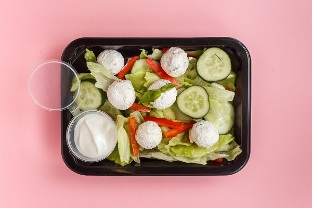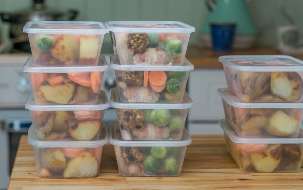What does a healthy diet plan for weight loss look like? What type of food should be excluded from the diet for PP, how much protein, carbohydrate and fat should you get daily?
Basics and rules of healthy eating

For optimal results, especially if you are starting a healthy lifestyle, you can follow the MyPlate method. That is, you divide each meal into 5 food groups. Read more about them.
protein
Protein should make up about 20 percent of your daily calories.
How much protein should you get?
You should consume about 0, 8 - 1, 2 grams of protein per kilogram of your body weight per day. You should try to consume this amount of all foods and snacks throughout the day before turning them into one or two foods. Protein is especially important if you are trying to achieve weight loss by burning fat in the body. The fact is that the breakdown and absorption of protein requires more energy than other macronutrients, leading to higher caloric expenditure.
Cereals
Cereals often have a bad reputation because most grain foods today are industrially processed into fast carbohydrates such as sweet grains and white bread. If you choose unprocessed grains and grains, you will immediately get all the benefits of grains: energy, vitamins and minerals for the normal functioning of the body.
How many grains do you need?
You need about six servings of grains or 170 grams a day. Serve a slice of bread and half a cup of cooked rice or pasta. At least half of your favors should be cereal.
Fruits
What else should you include in your diet to lose weight? Fruits. Even the fact that fruits contain sugar, more specifically fructose, is not a problem if you do not exceed your daily calorie intake. Your body needs fructose to stay healthy. Thus, fruits are naturally sweet, which means they can satisfy your sugar cravings if you do not want to eat chocolate at night.
How many fruits do you need?
You should get about two servings a day. Whole apples, oranges or bananas are considered one serving.
Which fruit should you choose?
You should eat mostly fresh fruit and limit your intake of fruit juices and processed foods, such as apple sauce (unless you do it yourself).
Vegetables
If you really want to know how to eat to lose weight, just remember vegetables - your new best friend. They are rich in fiber, which is beneficial for your digestive system. They are also low in calories and saturation, so you can eat more vegetables than other foods and get fewer calories at a time, which ultimately leads to quality weight loss.
How many vegetables should you eat?
You need three to four servings.
Which vegetables to choose?
Try to eat lots of dark green leafy vegetables like spinach, kale, broccoli and asparagus. Potato starchy vegetables are also beneficial. Preparing vegetables (not boiling because it removes all nutrients) is one way to improve the flavor if you do not like their raw material.
Dairy products
We consume dairy products with large amounts of vitamins and minerals. It is a high protein food, so a curd-like meal is ideal if you need to eat something before your next dinner. Since dairy products are generally a great source of protein, they are also part of the weight loss package.
How many dairy products do you need?
About, you need about three servings of dairy products every day. One cup of milk or yogurt is considered one serving.
What if you can not / do not want dairy products?
Not only dairy products but their nutrients are important for a healthy diet. So, if you can not eat dairy products due to allergies or lactose intolerance, or just do not like them, there are other potential ways to get these essential vitamins and minerals and still get great results.
- Broccoli, cabbage, figs and oranges are rich in calcium.
- Dark green leafy vegetables (cabbage, broccoli), tomatoes and citrus fruits contain vitamin C.
- Minerals such as phosphorus, magnesium and iron are found in many other foods you already eat.
- You can also take a multivitamin daily to supplement these micronutrients.
What about fat?
Fats and oils are no longer technically a separate food group. During dieting, you automatically consume the fats you need to stay healthy.
And where do I get fats?
If you eat a healthy variety of foods, you need to get all the healthy fats you need. No more than 30 percent of your daily calories should be from fat.
The truth about carbohydrates
You have probably already heard that not all carbohydrates (sugars) are bad. When you see experts talking about how bad sugar is for you, they usually talk about added sugar. This type of sugar is added to our food during processing for many reasons and should be limited if not excluded.
However, carbohydrates in cereals, fruits, vegetables and dairy products are not moderately harmful. This type of sugar should not scare you. In your body it turns into the energy you need to stay healthy.
How many calories should I take in per day?

Now that you know how to eat to lose weight, you are probably still wondering how many calories you can get in a day. Technically, you do not need to count calories if you do not want to. Female and male standard 2000 kcal. You can calculate your calorie needs if you really want to know and track them daily, but it all depends on what you eat and how active you are. Instead, focus on food types and troop sizes, as this can be a much more efficient but less difficult way to achieve results.
Calculate your daily calorie intake for weight loss
To find out how many calories you need per day, you can use one of the formulas for calculating calories. The most commonly used formula is Tom Venut. It looks like this:
Male: 66+ (body weight 13, 7 x) + (cm 5 x height cm) - (6, 8 x years old)
Women: 665+ (9. 6 x body weight) + (1. 8 x height cm) - (4. 7 x age years)
The number obtained is multiplied by the physical activity coefficient:
- Sedentary work, sedentary lifestyle: 1. 2
- Average stress level (morning workouts 3 times a week) 1. 38
- Heavy loads 1, 56
- Very heavy loads 1, 73
- Extreme extreme (you can not get that much, do not even think about it. 1. 9
But if you start asking questions like "Why can't you lose weight? ", it may turn out that your daily calorie intake is too excessive and your body just does not need to expend fat stores. In this case, it is better to calculate your daily calorie intake and compile a menu based on the data obtained. It is especially important to know the caloric content of the diet, when the weight stops after achieving certain results, then it will be easier to reduce the diet by another 500 calories and the weight loss will continue.
One favor is:
- 100-150 grams of vegetables (fist size);
- 150 ml dairy products;
- 120 g meat or fish (palm size; )
- 1 h. K. Vegetable oil;
- 12 grapes;
- 1 apple, banana, orange or pear;
- 1/2 mango or grapefruit;
- 1/4 avocado.
Keep track of your balance
To lose weight without harm to health and to maintain health, harmony, the body must receive enough proteins, fats and carbohydrates. Estimated proportion - 75 g Protein: 60 g Fat: 250 g Carbohydrates: 30 g Fiber. Protein-rich foods are a source of amino acids for building muscle fibers, keeping skin, hair, and nails healthy, and for the brain and nervous system to function properly, as well as for the skin, and carbohydrates are a source of energy.
Does feeding time matter?
Optional. Make it easy on yourself and eat hungry, even if it is just snack food. If you prefer to eat six small meals a day rather than three large meals, do so. If you want to eat in the valley once every few hours, then it is enough to eat 3 times a day at a suitable time. Just do not miss a meal (you end up eating, but somewhere overnight and sabotaging potentially quality results). Diet is important, but not in terms of time, but in terms of quality.
Menu and meal planning
Eat several complete and balanced meals every day while maintaining a healthy diet. The secret is to eat different foods. Below is a sample breakfast, lunch and dinner menu to help you plan your meals.
Daily ration:
Breakfast
- low-fat Greek yogurt or oatmeal with fruit and granola
- half a bagel of low-fat cream cheese
Lunch
- 2 items shawarma (tortilla, beef, lettuce, guacomole, sour cream)
- 1 cup boiled brown rice with baked beans
Dinner
- Small salad (lettuce, red onion, tomato, cheese, Italian dressing)
- Baked chicken breast
- 1 cup green beans
- Baked potatoes with cheese
Food Ideas
- Celery and hazelnut butter
- Fresh vegetables with hummus
- sliced fruit and whipped cream
- Applesauce
- Presley
- dried
- nuts
- tortilla and salsa
- pickled cucumber
Shopping list
Here are some examples of healthy foods you can buy at your local grocery store. Knowing which foods to buy is part of a weight loss package.
Healthy food:
- Meat (steak, pork, beef)
- fish and shells
- eggs
- nuts and seeds
- Cereal
- Whole grain pasta
- Brown rice
- Buckwheat
- Whole grain bread
- Greek yogurt
- cheese
- milk or soy milk
- avocado
- fatty fish such as salmon
- nuts
- fatty yogurt
Healthy Eating Planning Guide for Beginners

Eating planning is one of the easiest and healthiest things you can do to achieve weight loss through a healthy diet. Whether it's just a day or a whole week, it's up to you. A properly formulated diet not only allows us to lose weight, but is also convenient when all food issues are resolved in advance. When the ingredients of a tasty and healthy dish await us at home, it becomes easier to avoid buying a harmful item.
1. How many meals do you need?
First of all, let’s think about our plans and the plans of our loved ones for the week. From this we can get a rough idea of how many meals we need. This could be, for example: six breakfasts for everyone, five family dinners, one lunch four times and one afternoon snack.
2. How long will it take to prepare?
This is a very important element of nutrition planning and is often overlooked or forgotten. You can make as many plans as you want, but if you do not have enough time to execute them, then what are they useful for? With that in mind, expand your list with pre-prepared lunches and lunches. This means that you should first get acquainted with the dishes you prepare - the more information you find about them, the easier it will be to find dishes that easily fit into your schedule.
If you have a tough work week ahead of you, consider fast food, refreshments, or pre-cooked meals. Do we not want to waste time cooking, do it five times a day. Once you have done the work, you can immediately prepare a few dishes that you will enjoy throughout the week. For example, make chili or fry two chickens at the same time so that it is enough for both today's dinner and the next day. Moreover, it will be a tasty and healthy addition to sandwiches and salads.
3. Selection and schedule of dishes
Use your list to choose a meal that fits organically into your schedule. Also, take a look at your loved ones ’favorite foods or browse the recipe book. You also need to consider the time of year, what is on sale now from seasonal vegetables and what everyone wants to eat. When planning, you should also keep in mind the expiration date of the product. For example, fish dishes should be cooked for one or two days after buying fish, while frozen or dry food may be cooked later.
You also need to be able to use all the ingredients wisely so that you do not have to throw anything away. This way you can save both time and money. If you want to eat better and spend less money, then buy seasonal products and look for products with discounts and promotions.
Make a list of the best recipes. Having a list of dishes that work for you and your family is one of the easiest ways to calculate and simplify your meal planning process. Whenever you find a recipe for the dish you want, put it on this list. You can also save the recipes in your fitness diary. This will not only help you in your diet but also make your meal planning easier.
4. Enter everything in the calendar
It does not matter which calendar you use, be it on your computer screen or on the wall. But it is always best to have a clear copy of your calendar paper. It is usually hung in the refrigerator. When today’s meal plan is visible, then we will be more responsible for preparing them. Also, your family does not constantly ask, "What is dinner for today? " They can just look at the calendar.
If you prefer a digital calendar, you can create a plan for today's meal on your phone and share this menu with friends and family.
5. Make shopping lists
This is best done in parallel with filling out the calendar. Remember to write down the quantity of each product you need, and also check how much is left so that you do not accidentally buy too much. You can save time by grouping the products on the list as they appear in the store. For many supermarkets this is:
- Fruits and vegetables
- Bread and cereals
- Spices and Baking Products
- oils
- crackers
- Drinks
- Dairy products
- Meat and eggs
6. Preparing and preparing dishes
Press the vegetables, grate the cheese, prepare the sauces - just prepare what we can in advance. You can also measure spices, cook potatoes, or roast vegetables.
Planning a meal not only puts us in the main position to achieve a healthy diet, but it also saves us a ton of time as we can prepare the ingredients while you have free time.














































































